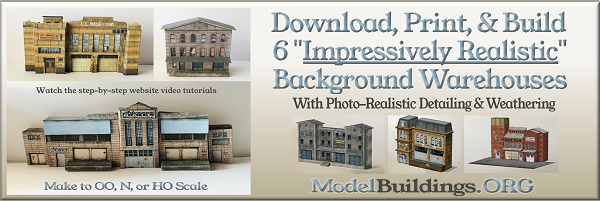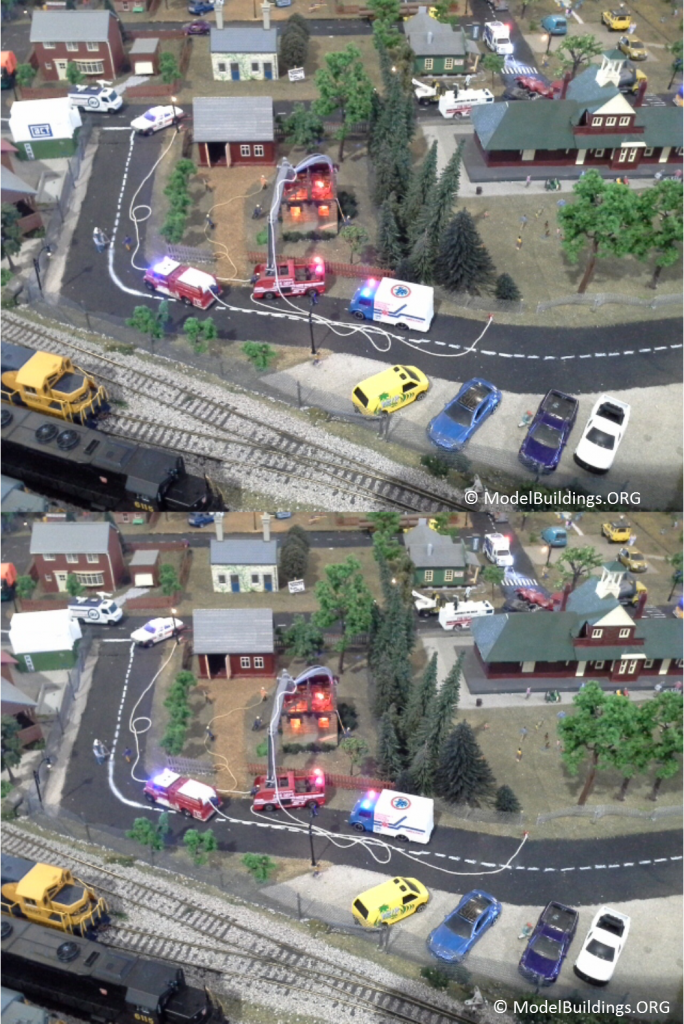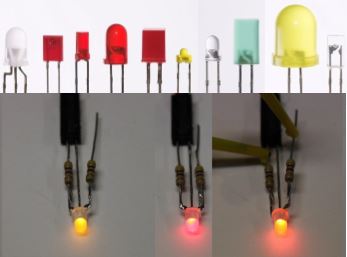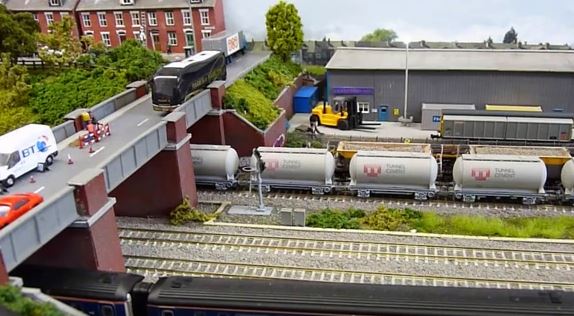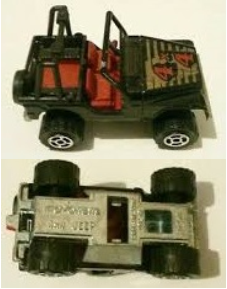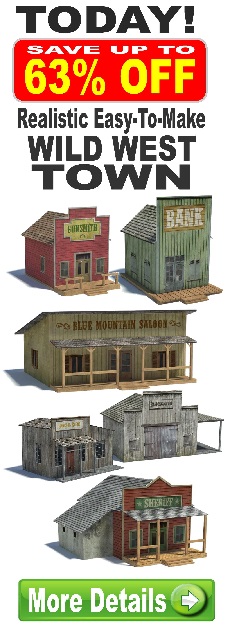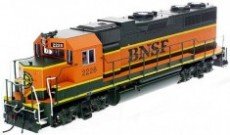Everything on model trains, model railroads, model railways, locomotives, model train layouts, scenery, wiring, DCC and more. Enjoy the world's best hobby... model railroading!
How To Make A Realistic Fall (Autumn) Scene
Simon asks readers:
“I have mountain and I’m trying to make a realistic fall theme. I have grand central jims pine trees and orange birch trees, but I don’t know how to make it a realistic fall scene with some bare spots at the top.”
Spot The 7 Differences in this Model Railroad Fire Scene
The response to our first SPOT THE DIFFERENCE photo a couple of weeks ago was amazing. In the reader poll a whopping 84% said they would like to see more spot the difference photos on the blog. So, here is a second photo which has 7 differences. Can you spot them? Click the COMMENTS link to list your solutions.
The Advantages of Using LEDs (Light Emitting Diodes) for Model Railroads
LEDs have numerous applications in model railroading including:
• Locomotive headlights and internal passenger car lighting
• Warning lights for the rear end of trains (cabooses, passenger cars etc)
• Structure illumination
• Signage illumination
• Railroad signals
• Panel indicators
LEDs also have many advantages over traditional incandescent lights including:
• The cost: It is hard to put an exact figure on it, but LEDs typically are around 20 to 40% of the cost of traditional incandescent light bulbs (depending on the project).
• Long life: Again depending on the usage, LEDs will typically last tens of thousands of hours. They will well and truly outlast traditional incandescent bulbs which almost eliminates the need to replace bulbs.
• Heat: LED bulbs give off virtually no heat so are a lot safer inside plastic structures or enclosures.
• Current: LEDs will typically draw just 10-30 milliamperes (0.010 – 0.030 amperes), which is much less than an incandescent bulb, so on larger projects you might get by with a smaller power supply.
• Color and consistency: You might have noticed how the color of incandescent bulbs becomes whiter when the brilliance increases. This is because they predominantly glow at red wavelengths. When the brightness increases so does their heat output. This also reduces the life expectancy of incandescent bulbs. By comparison Red, blue, yellow and green LEDs are monochrome so their color remains constant regardless of their brilliance.
Downsizing from HO to N Scale – How to Join Modules
Alex asks readers:
“We just moved into a smaller house and I did a lot of damage to my old HO layout deconstructing and moving it. It was harder than I thought it would be. Anyway, I decided to sell off the stuff to friend and start again in N scale because I don’t have as much space. This time I’ll build it in modules, but I’m unsure what’s the best way to join them for smooth rail joins, good connections, and easy dismantling if I do another house move?”
Finding Figures For Railroad Scene
Ed asks readers for advice:
“I recently read – Bring your layout to life by adding people and animals. Put the people in period dress. I agree whole heartedly, but I’ve encountered a problem. I’m currently putting together a short point to point N scale 4’x8” depiction of the area outside Yankee Stadium in the early 30’s. I’ll be running a trolley and have already got the buses and cars and trucks for the scene, but trying to locate 40-50 “period dressed” people has been a challenge. Men wore suit sand hats and ladies wore dresses and hats to a ball game in the period and I’ve yet to locate anything similar. Any ideas?”
Train Track Mystery
Daniel wonders if readers can solve his mystery:
“I have a mystery (for me). Have about 17 feet of what appears to be 027. Three rail in stainless. However, the pins have one end that fits the 027 and the other end fits O Gauge. Doesn’t appear to be handmade. What do I have? Thanks.”
Switch Machines and Power
Ethan asks readers for advice:
“Hey guys. I have been thinking about starting up my own model railroad in either HO or N scale and including a switching yard and a few sidings. I got to looking into the wiring for switch machines and decided that I want to use toggle switches with indicating lights. However, I noticed that most toggle switches will constantly power the switch to whichever line it is switched to. Will this not burn up the motor by constantly feeding it power trying to get it to move even after it has switched the turn out?”
Drawing Curves
Des asks readers:
“I am looking at the possibility of a model rail system in the future and I would like to draw the track layout first. My question is when drawing curves and the diameter is quoted at 20 ins – is that measured at the center of the two tracks or the inside or outside rail. I will most likely go OO.”
Spot The Difference
Remember as kids playing “spot the difference” between two cartoons or drawings… well, why shouldn’t we have the same fun a few years on?
The two photos below of a model layout scene look the same, but there are actually 6 subtle differences between the two. Can you spot them?
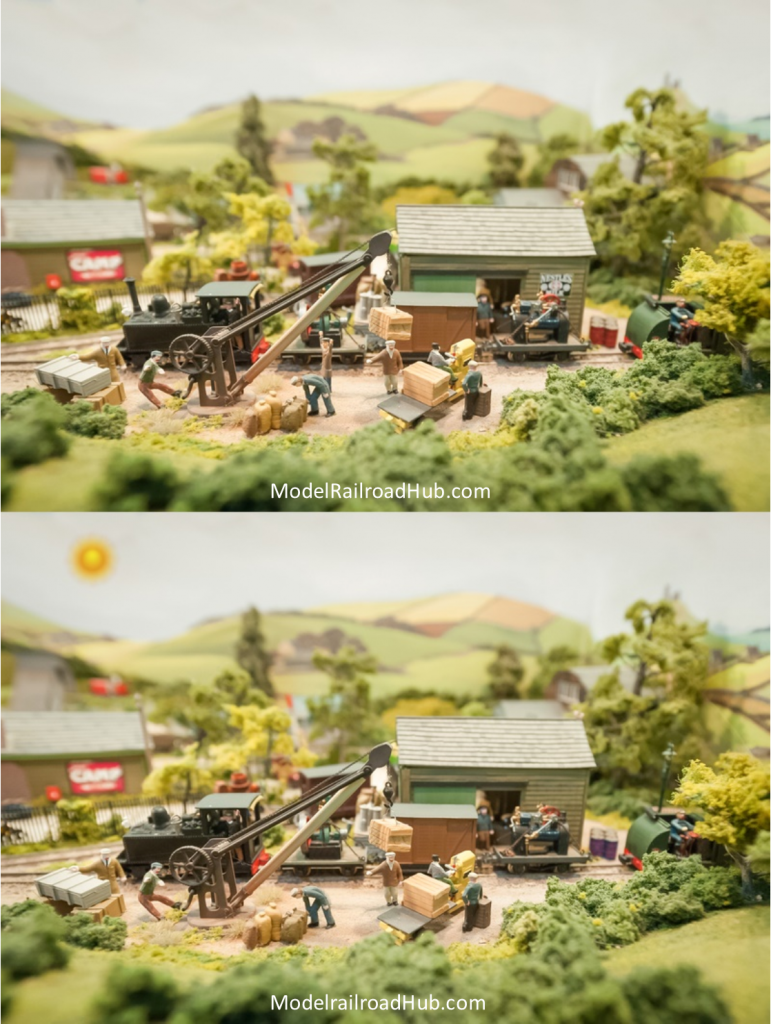 If you want to be the first to supply the 6 answers, you can submit them using the “Comments” link below.
If you want to be the first to supply the 6 answers, you can submit them using the “Comments” link below.
It would also be good to get your feedback (using the “Comments” link). Would you like to see more “Spot the Difference” photos added in future weeks?
Reader poll results since posting these photos showed 84% wanted to see more “Spot The Difference” photos in coming months, so YES will bring you more.
Congratulations to Carl, Ron, Mickael, Lou, Ken, John R, Gordon, William, and Newman who were the first to correctly spot all 6 differences. You can see their answers in the comments (see below).
Problems Lining Up Track
David asks readers:
“My attempts at laying the base cork using the track centers is roving problematic, because I’m finding it hard to mark the actual line with my track in place on the plywood. I think I need a tool to mark the center line. Trying to line it up by eye is near impossible. I thought maybe attaching a pencil to a two wheel truck might work if I could mark a dot through the mounting hole of the truck. Does anyone have any brighter ideas? What do other use to solve this problem? I hope my question makes sense. My scale is HO.”
Questions about Using LED Lights as Locomotive Headlights
Aaron asks readers for advice:
“I have heard so many good things about LEDs, so am thinking about upgrading my N scale DCC diesel loco headlights, and maybe using them for ditch lights and markers. Does anyone have any tips for powering them independently, what type to use for each function, how to get a constant intensity from each light, other uses for LEDs etc. And any other tips appreciated. Thanks.”
